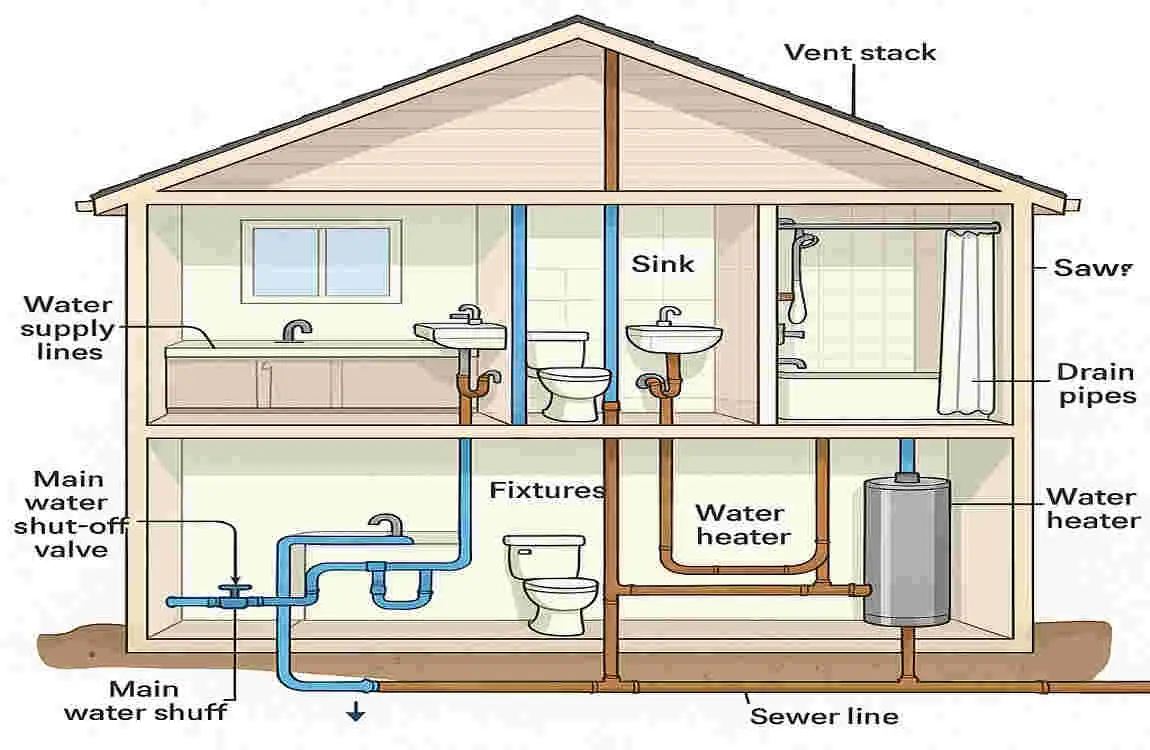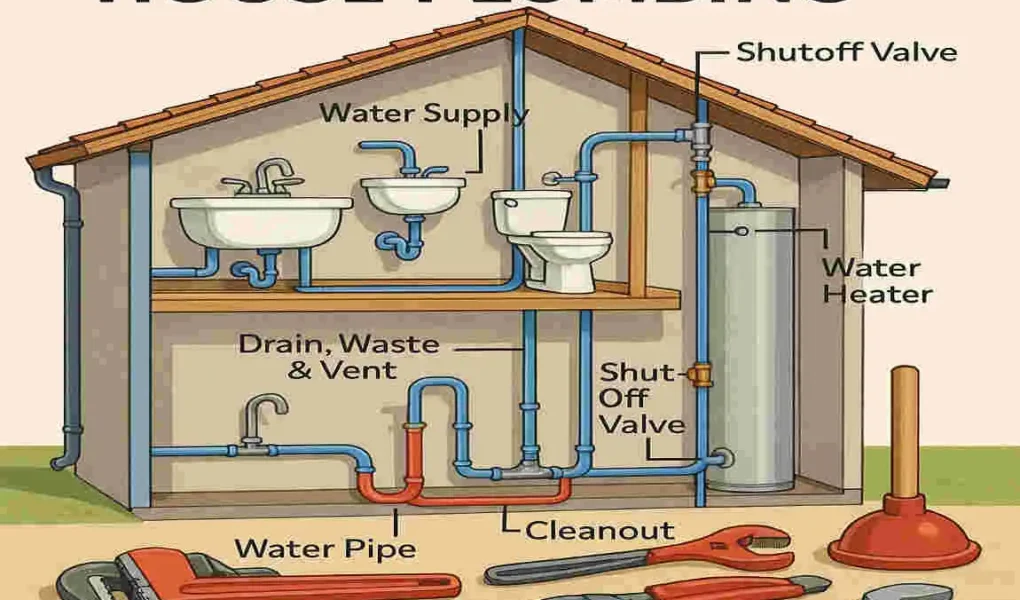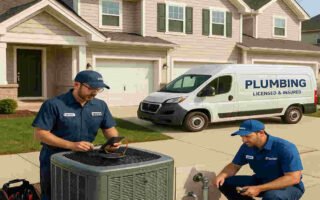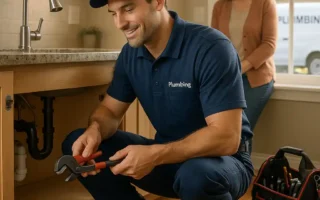Imagine this: you’re enjoying a relaxing shower after a long day when suddenly, the water turns cold. Or worse, you wake up to a flooded bathroom due to a burst pipe. Understanding your home plumbing system can save you from these nightmares and help you maintain a comfortable living space.
We’ll also discuss how to maintain your system for longevity and when it’s time to call in the professionals. By the end, you’ll have a solid foundation to start your own plumbing adventures.
Understanding the Basics of a Home Plumbing System

What is a Home Plumbing System?
At its core, a home plumbing system is a network of pipes, fixtures, and appliances that deliver clean water to your home and remove waste. It’s like the circulatory system of your house, ensuring everything flows smoothly.
Key Components of a Home Plumbing System
- Pipes: These are the highways of your plumbing system, carrying water throughout your home. They can be made of various materials, such as PVC, copper, or PEX.
- Fixtures: These are the endpoints of your plumbing system, including sinks, toilets, showers, and faucets.
- Valves: These control the flow of water in your system, allowing you to turn it on or off as needed.
- Drains: These carry wastewater away from your home and into the sewer system.
- Water Heater: This appliance heats water for your showers, sinks, and appliances.
- Sewer Line: This is the main pipeline that carries waste away from your home.
Types of Plumbing Materials
When it comes to plumbing materials, you’ll often encounter:
- PVC: A durable, affordable plastic commonly used for drain and vent pipes.
- Copper: A traditional choice for water supply lines, known for its longevity and resistance to corrosion.
- PEX: A flexible, easy-to-install plastic tubing that’s gaining popularity for water supply lines.
How Water Flows Through the System
Water enters your home through the main water supply line, usually located near the street. From there, it flows through a meter that measures your usage and then into your home’s plumbing system. The water travels through pipes to your fixtures, where you can use it for drinking, cooking, bathing, and more. After use, the wastewater flows through the drain pipes and out of your home via the sewer line.
Common Plumbing Terms
As a beginner, it’s helpful to know these basic plumbing terms:
- Drain: The pipe that carries wastewater away from your home.
- Vent: A pipe that allows sewer gases to escape and helps maintain proper pressure in the drain system.
- Trap: A curved section of pipe under a fixture that holds water to prevent sewer gases from entering your home.
- Fixture: Any device that delivers water or removes waste, such as a sink or toilet.
Common Problems in Home Plumbing Systems and What Causes Them
Frequent Plumbing Issues
Even the best-maintained home plumbing system can encounter problems. Some of the most common issues include:
- Leaks: These can occur in pipes, fixtures, or appliances and can lead to water damage and high bills.
- Clogs: Blockages in your drain pipes can cause slow drainage or backups.
- Low Water Pressure: This can be caused by a variety of factors, from mineral buildup to problems with the municipal water supply.
Causes Behind Each Problem
Understanding the root causes of these issues can help you prevent them or address them more effectively:
- Corrosion: Over time, pipes can corrode, leading to leaks or reduced water flow.
- Blockages: Grease, hair, and other debris can accumulate in your drain pipes, causing clogs.
- Freezing Pipes: In cold weather, water in your pipes can freeze and expand, causing them to burst.
Signs to Watch For
Catching plumbing problems early can save you time, money, and headaches. Keep an eye out for these warning signs:
- Water stains or puddles: These can indicate a hidden leak.
- Slow drainage: This may be a sign of a developing clog.
- Unusual noises: Gurgling or banging sounds can point to issues with your pipes or fixtures.
How These Issues Affect the Whole System
Plumbing problems don’t just affect the immediate area—they can impact your entire home plumbing system. A leak in one part of your house can lead to low water pressure elsewhere, while a clog in a drain can cause backups in multiple fixtures.
Tools and Techniques for Beginners to Tackle Basic Plumbing
Essential Plumbing Tools
As a beginner, you don’t need a complete toolbox to tackle house basic plumbing tasks. These essential tools will help you get started:
- Plunger: A must-have for clearing clogs in toilets and sinks.
- Pipe Wrench: This adjustable wrench is perfect for tightening or loosening pipe fittings.
- Teflon Tape: Also known as plumber’s tape, this helps create a watertight seal on threaded connections.
Simple DIY Plumbing Techniques
With the right tools and a bit of know-how, you can handle many common plumbing issues yourself:
- Unclogging Drains: Use a plunger or a drain snake to clear blockages in your sinks, tubs, or toilets.
- Fixing Dripping Faucets: Often, a dripping faucet is caused by a worn-out washer or O-ring. Replacing these parts can stop the leak.
- Shutting Off Water Valves: Knowing how to turn off the water supply to your home or individual fixtures is crucial for emergencies and repairs.
When and How to Safely Turn Off the Water Supply
In a plumbing emergency, you may need to turn off the water supply to your home. Here’s how:
- Locate your main water shut-off valve, usually found near the water meter or where the main water line enters your home.
- Turn the valve clockwise until it stops. This will cut off the water supply to your entire home.
- If you need to turn off the water to a specific fixture, look for a smaller shut-off valve near the fixture and turn it clockwise.
Troubleshooting Without Professional Help
Before calling a plumber, try these troubleshooting steps:
- Check for obvious issues: Look for visible leaks, loose connections, or clogs.
- Test the water pressure: Low water pressure can be caused by a variety of factors, so it’s helpful to rule this out first.
- Research standard solutions: Many plumbing problems have simple, DIY solutions that you can find online or in a home repair manual.
How to Maintain Your Home Plumbing System for Longevity

Routine Maintenance Tasks
Regular maintenance can help keep your home plumbing system running smoothly and prevent costly repairs. Here are some tasks to add to your to-do list:
- Drain Cleaning: Use a drain cleaner or baking soda and vinegar to keep your drains clear and prevent clogs.
- Inspecting Pipes: Check your pipes for signs of corrosion, leaks, or damage, and address any issues promptly.
- Checking Water Pressure: Low water pressure can indicate a problem with your plumbing system, so keep an eye on it and investigate if it drops.
Seasonal Plumbing Tips
Your plumbing needs can change with the seasons. Here are some tips to keep in mind:
- Winter Preparation: Insulate exposed pipes, disconnect outdoor hoses, and keep your home warm to prevent frozen pipes.
- Summer Inspections: Check your outdoor faucets and irrigation system for leaks, and consider installing a water-saving device to reduce your summer water usage.
Benefits of Proper Maintenance
Maintaining your home plumbing system can have several benefits:
- Lower Water Bills: By preventing leaks and clogs, you can save money on your water bill.
- Increased Home Safety: Regular maintenance can help prevent water damage and mold growth, keeping your home safer and healthier.
- Longer System Life: Proper care can extend the life of your plumbing system, saving you money on repairs and replacements in the long run.
DIY vs. Professional Maintenance
As a beginner, it’s essential to know when you can handle maintenance tasks yourself and when it’s time to call in a professional:
- DIY Maintenance: Simple tasks like drain cleaning, inspecting pipes, and checking water pressure are well within the realm of a beginner.
- Professional Maintenance: More complex tasks, such as replacing pipes or repairing a water heater, are best left to a licensed plumber.
When to Call a Professional Plumber
Identifying Plumbing Issues That Require Expert Intervention
While a beginner can tackle many plumbing problems, some issues are best left to the professionals. Here are some signs that it’s time to call a plumber:
- Major Leaks: If you have a significant leak that you can’t stop or repair yourself, it’s time to call in the experts.
- Sewer Line Problems: Issues with your sewer line, such as backups or foul odors, require specialized equipment and knowledge to fix.
- Water Heater Issues: If your water heater is leaking, not producing hot water, or making strange noises, it’s best to have a professional take a look.
Risks of DIY Plumbing Beyond Beginner Skills
While it’s great to learn basic plumbing skills, tackling projects beyond your skill level can lead to more problems than solutions. Here are some risks to consider:
- Causing More Damage: Attempting a repair that you’re not familiar with can lead to further damage to your plumbing system or your home.
- Voiding Warranties: Some plumbing components may have warranties that are voided if a licensed professional does not repair them.
- Safety Hazards: Working with gas lines or electrical components can be dangerous if you don’t have the proper training and experience.
How to Choose a Reliable Plumber for Your Home Plumbing System
When you need to call in a professional, it’s essential to choose a reliable plumber. Here are some tips to help you find the right one:
- Ask for Recommendations: Ask friends, family, or neighbors for recommendations on trustworthy plumbers in your area.
- Check Licenses and Insurance: Make sure the plumber you choose is licensed and insured to work in your state.
- Read Reviews: Look for online reviews and testimonials from past customers to get a sense of the plumber’s reputation and quality of work.
What to Expect During a Professional Plumbing Service
When you hire a professional plumber, here’s what you can expect:
- Assessment: The plumber will assess the problem and provide a diagnosis and estimate for the repair.
- Repair or Replacement: Depending on the issue, the plumber will either repair the damaged component or replace it with a new one.
- Testing: After the repair is complete, the plumber will test the system to ensure it’s working correctly.
- Cleanup: A professional plumber will clean up any mess created during the repair and leave your home in good condition.
Emerging Technologies and Innovations in Home Plumbing Systems
Smart Home Plumbing Tools and Leak Detectors
Technology is revolutionizing the way we approach home plumbing systems. Smart home plumbing tools and leak detectors can help you monitor your system and catch problems before they become significant issues. These devices can alert you to leaks, low water pressure, or other matters via your smartphone or home automation system.
Eco-Friendly and Water-Saving Plumbing Upgrades
As we become more conscious of our impact on the environment, eco-friendly and water-saving plumbing upgrades are becoming increasingly popular. These upgrades can help you reduce your water usage and lower your bills while also minimizing your environmental footprint. Options include low-flow toilets and showerheads, dual-flush toilets, and greywater systems that reuse water from sinks and showers for irrigation.
Benefits of Modern Materials and System Designs for Homeowners
Modern plumbing materials and system designs offer several benefits for homeowners:
- Durability: Newer materials like PEX tubing are more resistant to corrosion and damage than traditional materials like copper.
- Ease of Installation: Many modern plumbing systems are designed to be easier to install and repair, saving you time and money.
- Flexibility: Flexible materials like PEX can be easier to work with, especially in tight spaces or when rerouting pipes.
How Beginners Can Benefit from Technology Enhancements
As a beginner, you may feel overwhelmed by the latest plumbing technologies. But don’t worry—many of these innovations are designed to be user-friendly and can help you maintain your home plumbing system more easily. For example, smart leak detectors can alert you to problems before they become significant issues. At the same time, easy-to-install water-saving devices can help you reduce your water usage without requiring extensive plumbing knowledge.




